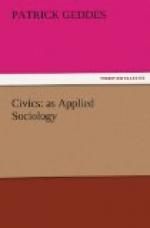It is in fact only as we can agree upon some definite and orderly method of description that our existing literature of social surveys can be adequately compared or new ones co-operatively undertaken. Hence the importance of discussions of scientific method such as those who have so largely occupied our first volume. Yet, I submit, here lies the means of escaping from these too abstract (and consequently too static) presentments of the general methodology of social science into which sociologists are constantly falling; and to which must be largely ascribed the prevalent distaste for sociology so general in this would-be practical-minded community in which we find ourselves, as indeed also the comparative unattractiveness of our studies to the body of specialist scientific workers, not even excepting those within what we consider sociological fields.
The history of each science, be it mathematics or astronomy, botany, zoology or geology, shows us that it is not enough to have the intelligent observer, or even the interpretative thinker with his personally expressed doctrine. This must be clearly crystallised into a definite statement, method, proposition, “law” or theory, stated in colourless impersonal form before it is capable of acceptance and incorporation into the general body of science. But while astronomer and geologist and naturalist can and do describe both the observational results and their general conceptions in literary form, requiring from the ordinary reader but the patience to master a few unfamiliar terms and ideas, they also carry on their work by help of definite and orderly technical methods, descriptive and comparative, analytic and synthetic. These, as far as possible, have to be crystallised beyond their mere verbal statement into formulae, into tabular and graphic presentments, and thus not only acquire greater clearness of statement, but become more and more active agencies of inquiry—in fact, become literal thinking-machines. But while the mathematician has his notations and his calculus, the geographer and geologist their maps, reliefs and sections, the naturalist his orderly classificatory methods, it has been the misfortune and delay of political economy, and no small cause of that “notorious discord and sterility” with which Comte reproached it, that [Page: 67] its cultivators have so commonly sought to dispense with the employment of any definite scientific notations; while even its avowed statisticians, in this country especially, have long resisted the consistent use of graphic methods.
I submit, therefore, for discussion, as even more urgent and pressing than that of the general and abstract methodology of the social sciences, the problem of elaborating a concrete descriptive method readily applicable to the study and comparison of human societies, to cities therefore especially. To do justice to this subject, not only the descriptive labours of anthropologists, but much of the literature of




